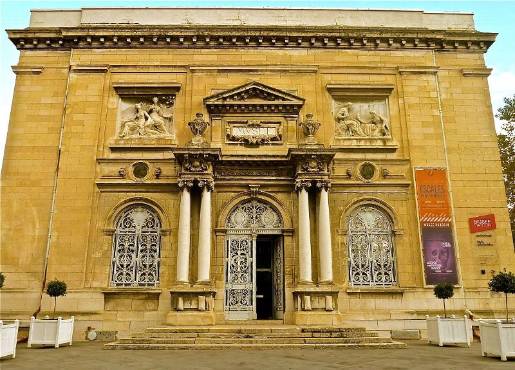
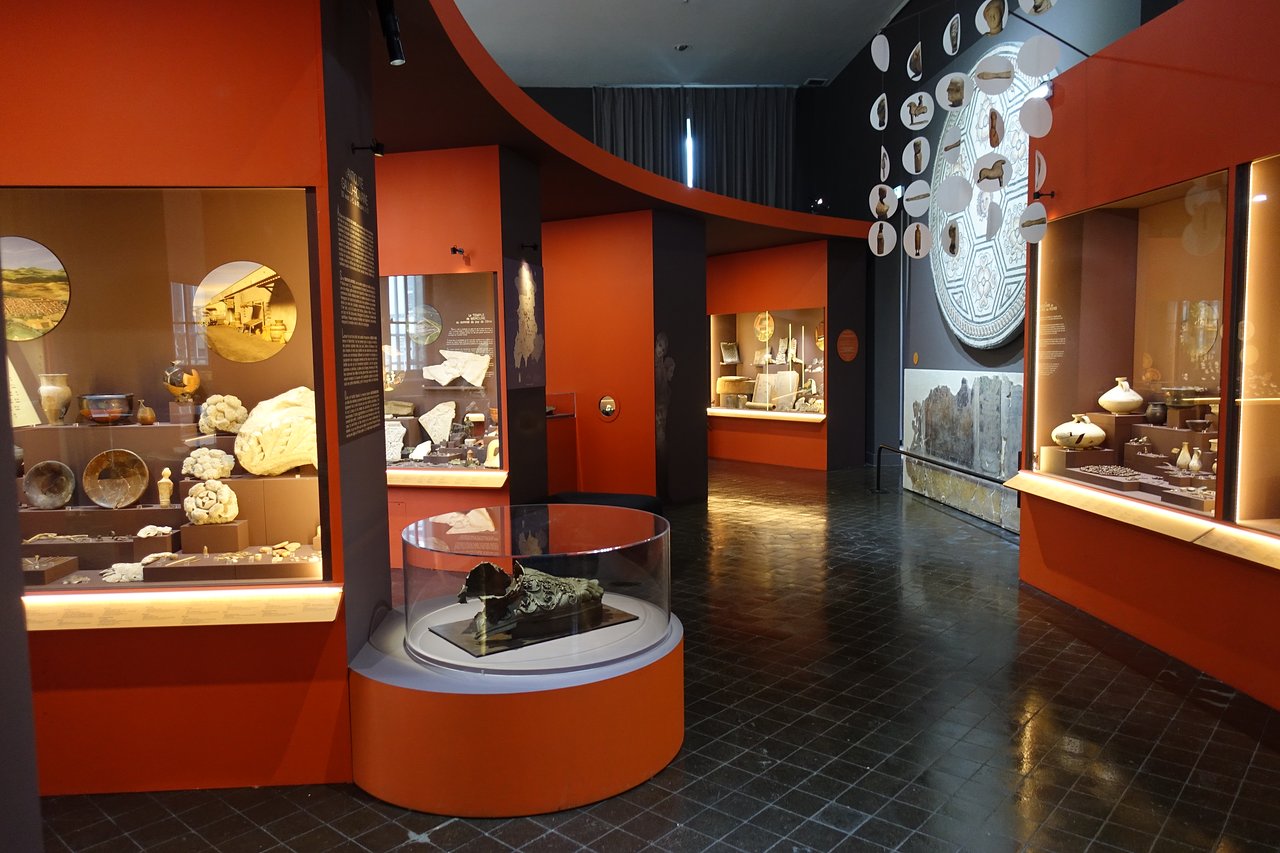
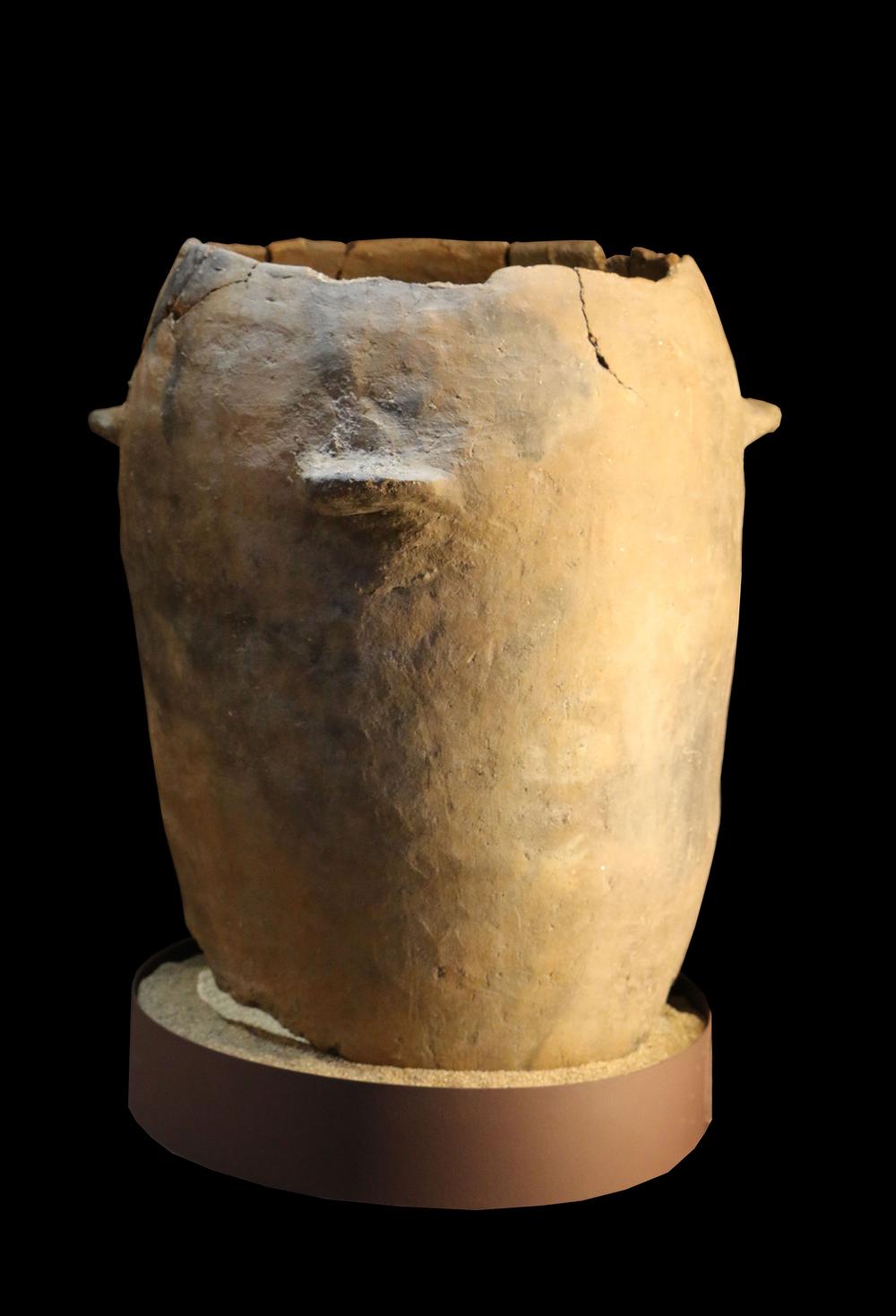
(2/ )
Néolithique final
Large earthenware jar, 60 cm high, dated to the end of the Neolithic period (around 2000 BC).
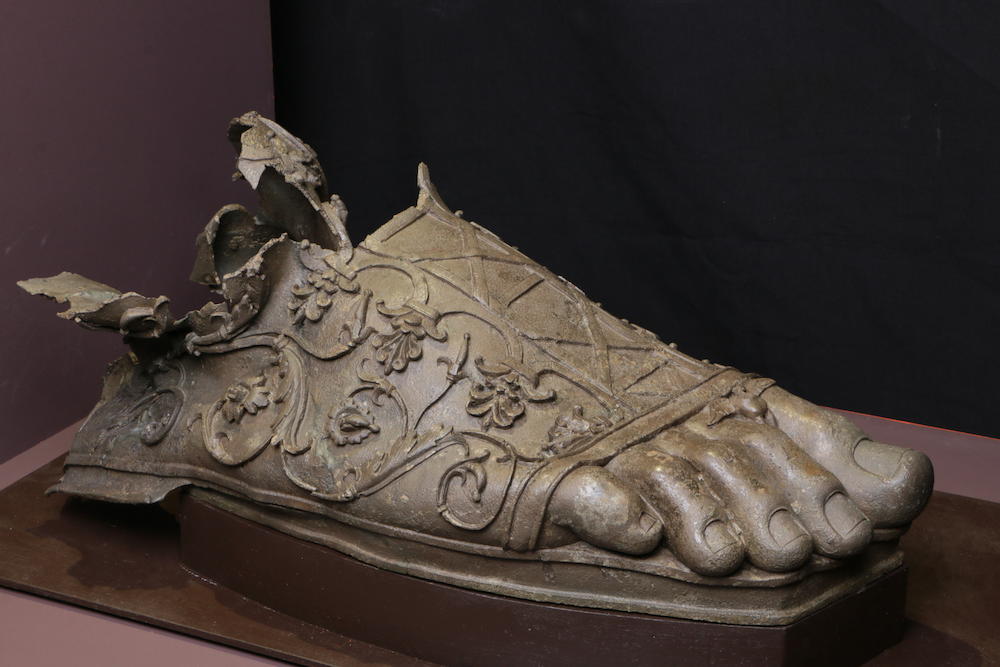
(3/ )
Early Imperial [27 / 235]
Right foot, wearing a boot with straps (mulleus) belonging to an imperial statue of almost 4 meters high. The decoration of the shoe (acanthus scrolls and palmettes) is characteristic of an imperial foot from the second century AD (Trajan, Hadrian?). On the other hand, the fineness of the copper alloy wall cast with lost wax is in the tradition of bronze statuary from archaic and classical Greece.
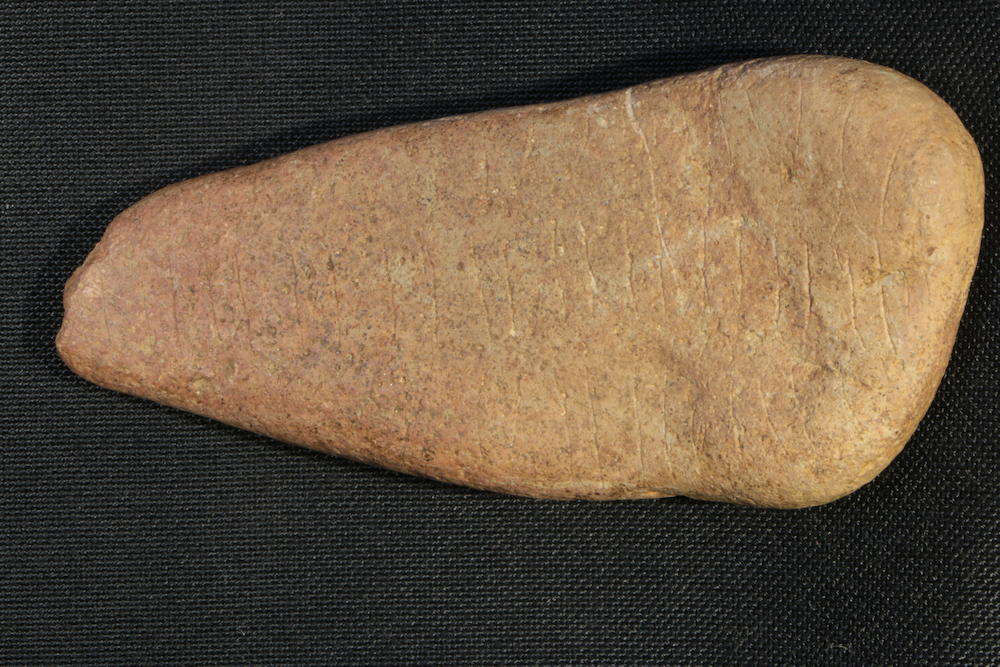
(4/ )
Middle Neolithic [- 4600 / - 3400]
Engraved pebble (fine striations) from a seasonal hunter-gatherer camp of the late Paleolithic (about 10,000 years before our era). It was found among stone tools that attest to hunting (Aurochs) and domestic activities.
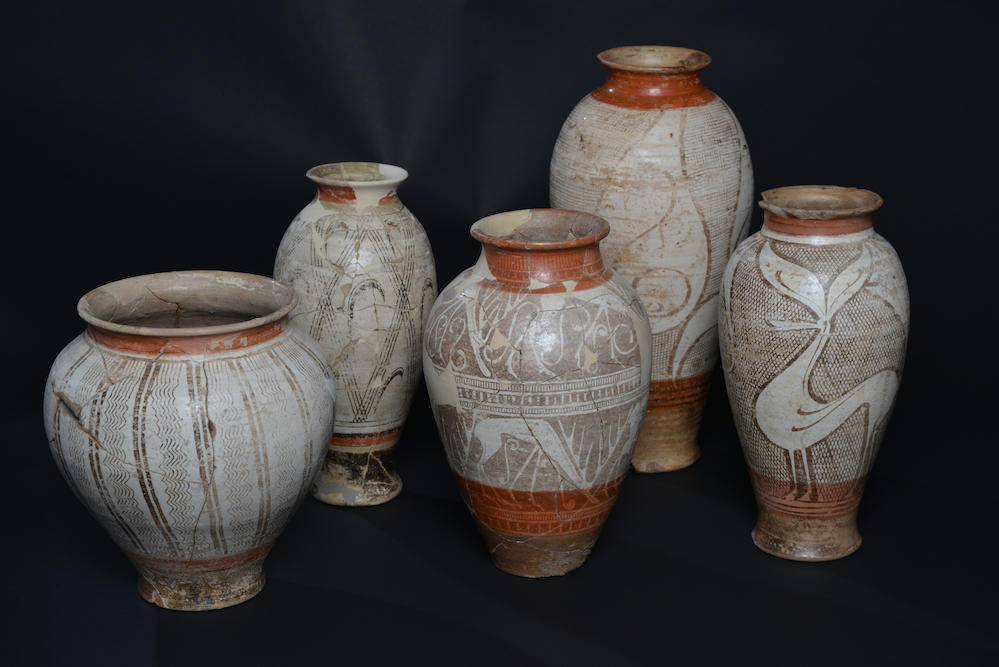
(5/ )
2nd Iron Age [- 480/ - 50]
Gallic vases in fine painted ceramics (late Iron Age, 2nd century BC). The decorations are mostly geometric or zoomorphic (deer). The Arvernian ceramists used the technique of the reserve, similar to that of Greek ceramics with red figures, but they used a black pigment of organic origin.
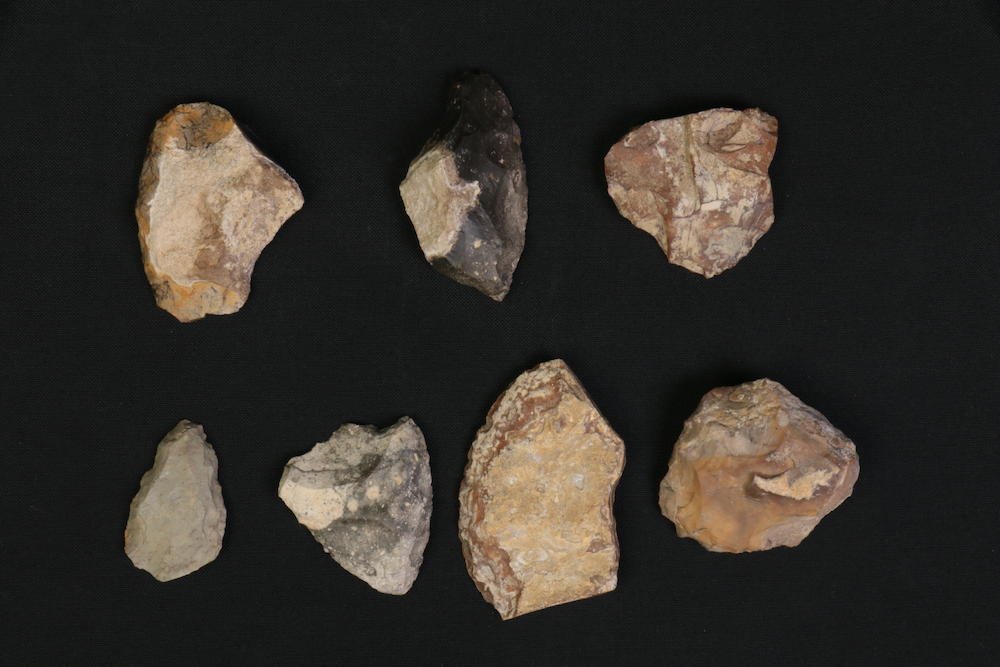
(6/ )
Middle Paleolithic [- 300000 / - 40000]
archaeology; paleolithic; lithic industry

(7/ )
Mesolithic [- 10000 / - 5500]
archaeology; mesolithic; lithic industry

(8/ )
Upper Paleolithic [- 400000/ - 10000]
archaeology; mesolithic; lithic industry
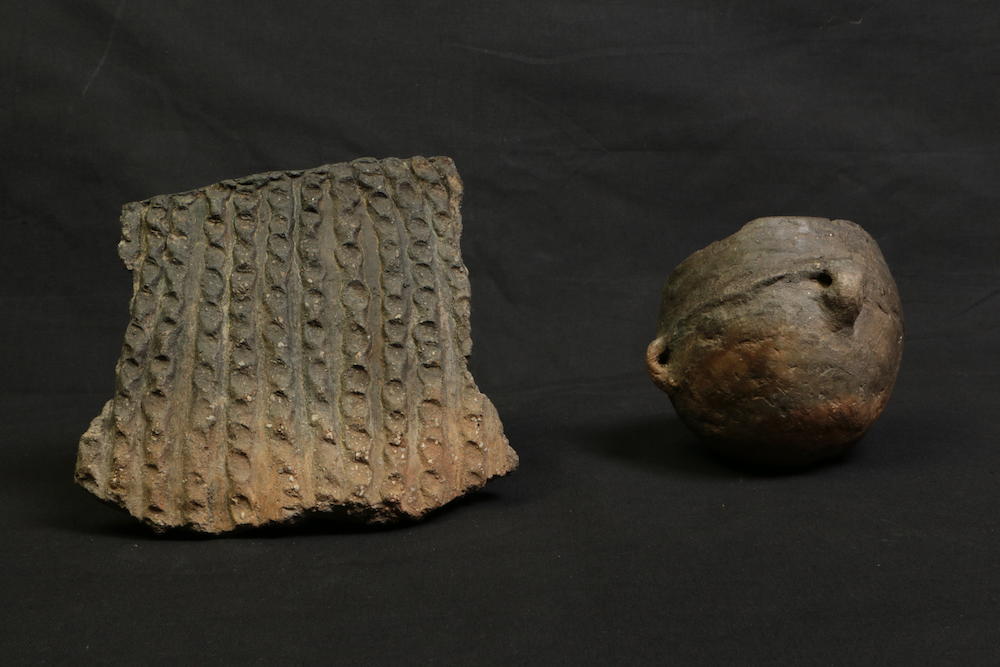
(9/ )
Middle Neolithic [- 4600 / - 3400]
Fragment of a vase body with printed decoration and a small round-bottomed vase with three handles dating from the Middle Neolithic (around -3500). The emergence of ceramics is a characteristic of the Neolithic.

(10/ )
Early Bronze Age [- 2200/ - 1600]
The Bronze Age saw the emergence of a whole range of copper alloy weapons. This dagger from the Early Bronze Age (2200 BC to 1700 BC) is a flat blade with a base perforated with eyelets to allow for the blade to be inserted.
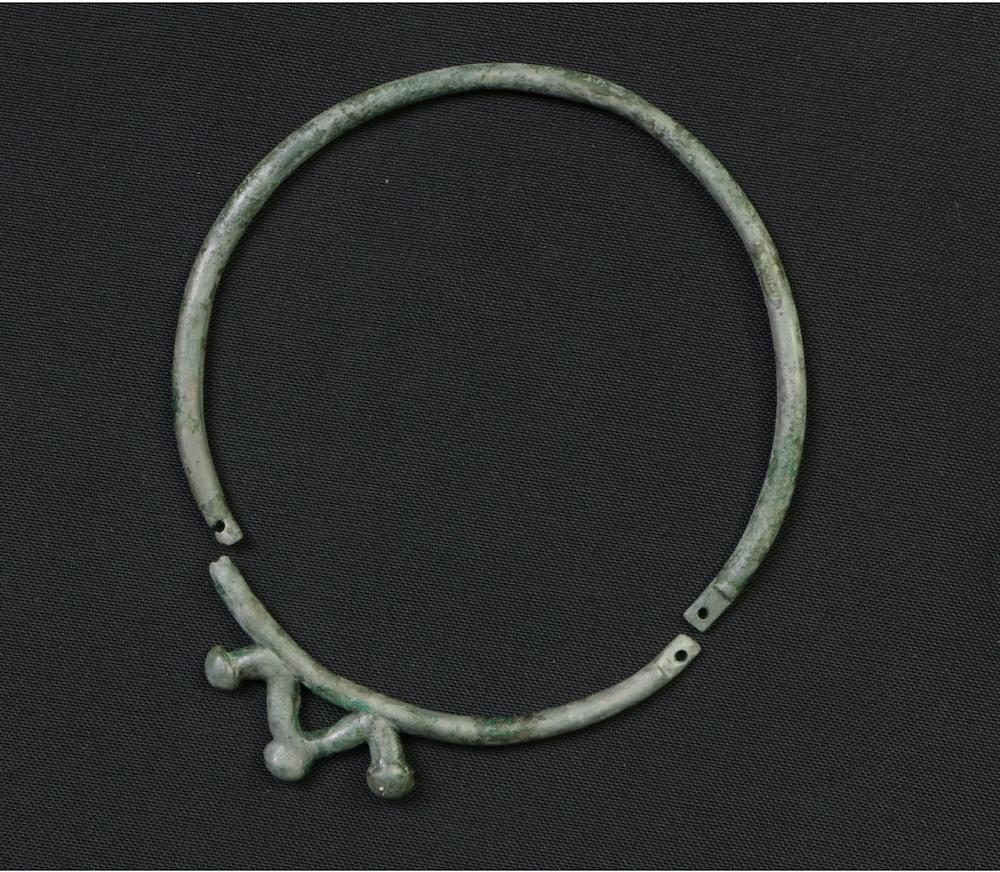
(11/ )
2nd Iron Age [- 480/ - 50]
A Gallic-era copper alloy child's necklace that opens with a removable element. Discovered in a burial site around the neck of a 6-8 year old child, it is attributed to the Second Iron Age (between the 4th and 3rd centuries BC).
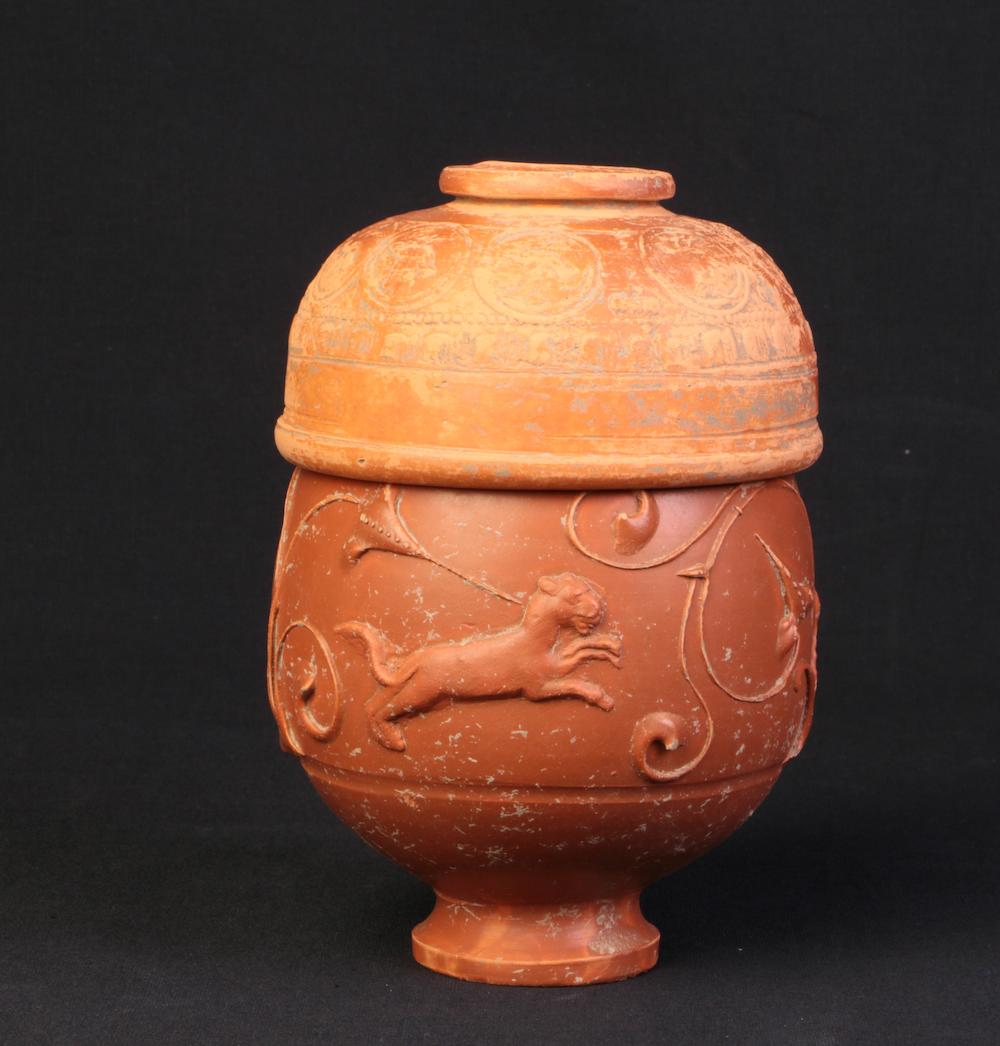
(12/ )
Early Imperial [27 / 235]
This sigilated ceramic goblet with relief decorations served as a cinerary urn. A cup was used as a lid.
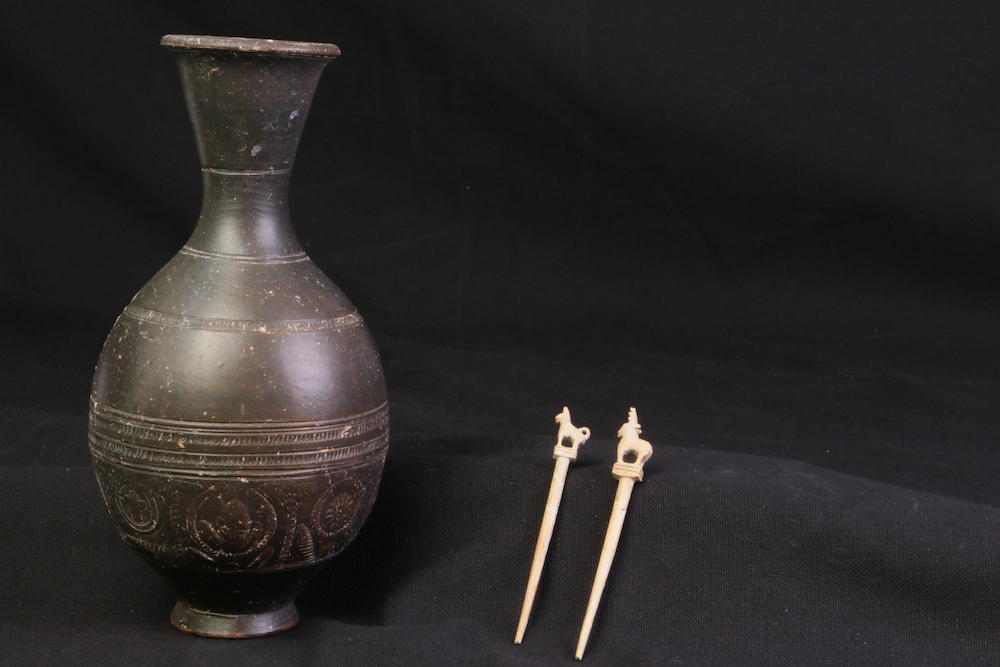
(13/ )
Bas-Empire [235/ 476]
This metallescent ceramic bottle and these bone hairpins with zoomorphic decoration were found in an adult's tomb in a necropolis of the High Kingdom (2nd-3rd century CE).
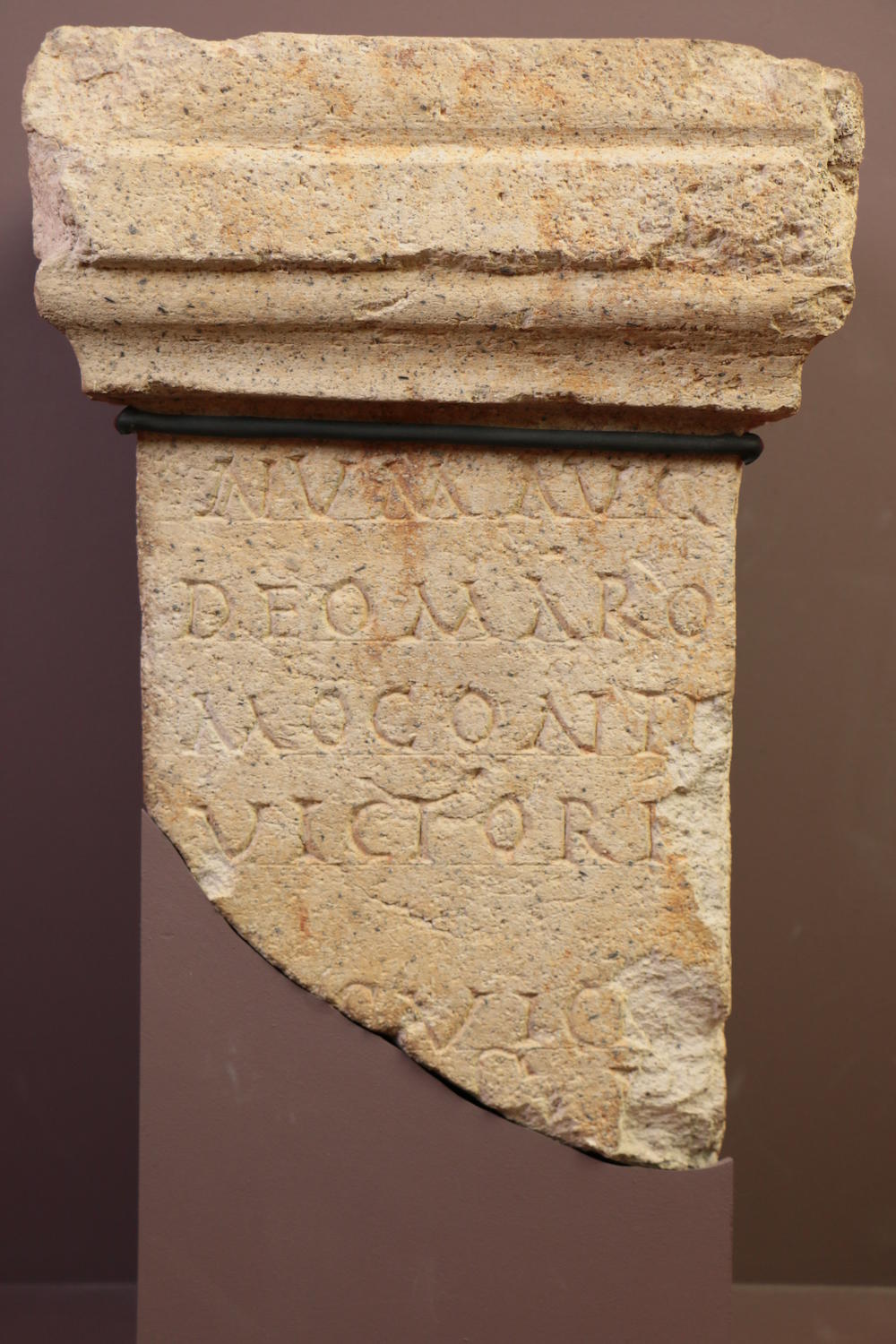
(14/ )
Gallo-Roman [- 50 / 476]
Votive altar made of volcanic rock from the 2nd century A.D. with an inscription. It is among the remains of a building that probably housed a professional or religious association (schola).

(15/ )
Mesolithic [- 10000 / - 5500]
Small but effective!
Aduring the Mesolithic period (10,000 to 7,000 years ago), human societies produced flint arrows, most often in geometric shapes, for hunting and fishing purposes. This period was marked by a major climatic and environmental change related to the end of the last ice age and the beginning of global warming, and saw the development of the forest and the arrival of new game adapted to these environments. These eleven arrowheads in the form of irregular triangles, or scalenes, probably come from a seasonal camp of hunter-gatherers of the Middle Mesolithic, 8,000 years ago. These very small objects, produced from flint blades or flakes, characterize the tools of the last hunter-gatherers. They were used to arm the ends or sides of projectiles used for hunting, notably arrows. Small in size, they testify to the extreme skill in producing effective weapons for hunting and defense. Thinness and lightness allow for increased use in the face of events.
These 11 irregular triangular or scalene-shaped arrow fittings likely originated from a seasonal hunter-gatherer encampment of the Middle Mesolithic period, circa 6000 B.C.E.
.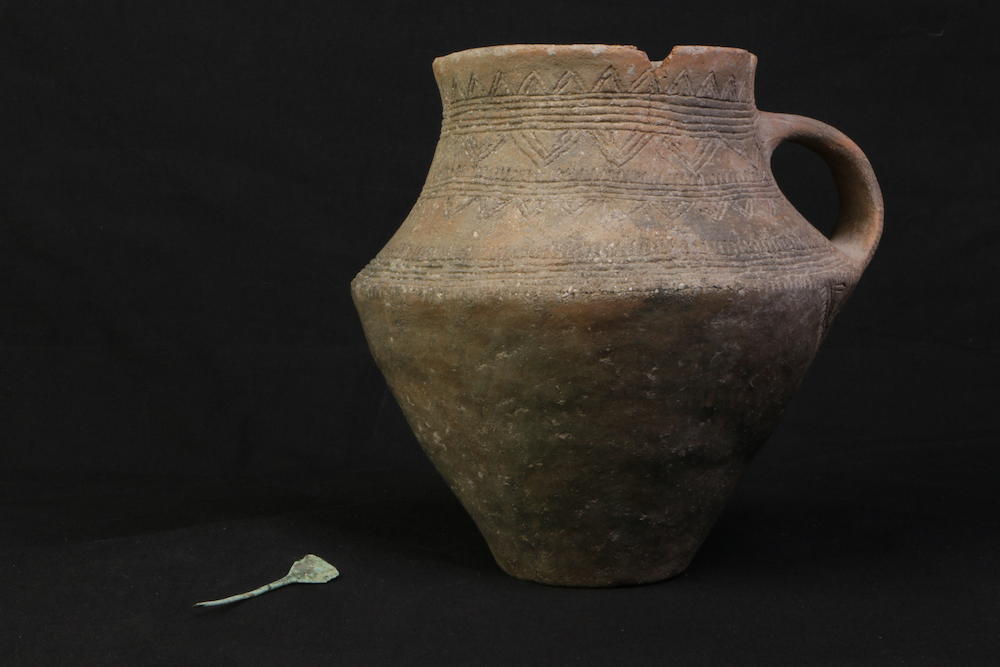
(16/ )
Bronze Age [- 2200/ - 800]
This carinated terracotta vase contained the ashes of a man and a copper alloy pin. Cremation was a common funerary practice during the Bronze Age (2200 BC to 800 BC).
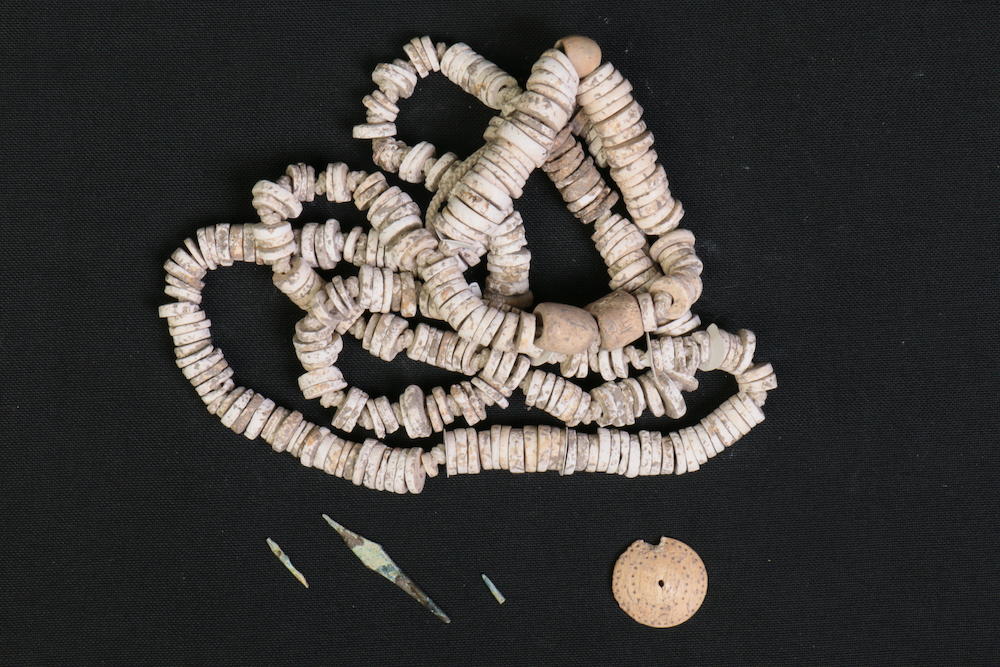
(17/ )
Bronze Age [- 2200/ - 800]
Diamond-shaped awl, copper alloy points and bone bead necklace from the Early Bronze Age (2200 to 1600 BC), found in a woman's burial site.
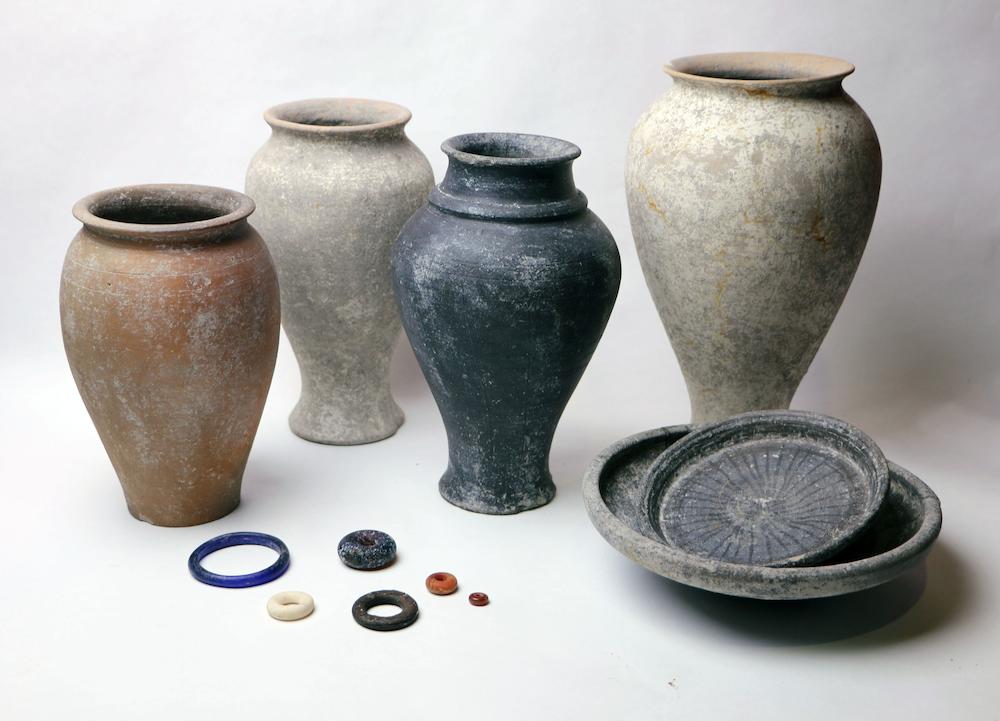
(18/ )
2nd Iron Age [- 480/ - 50]
Furniture from two women's tombs from the Second Iron Age (140-90 BCE). The ceramic furniture shows the importance given to food and objects of adornment in the funeral rites.
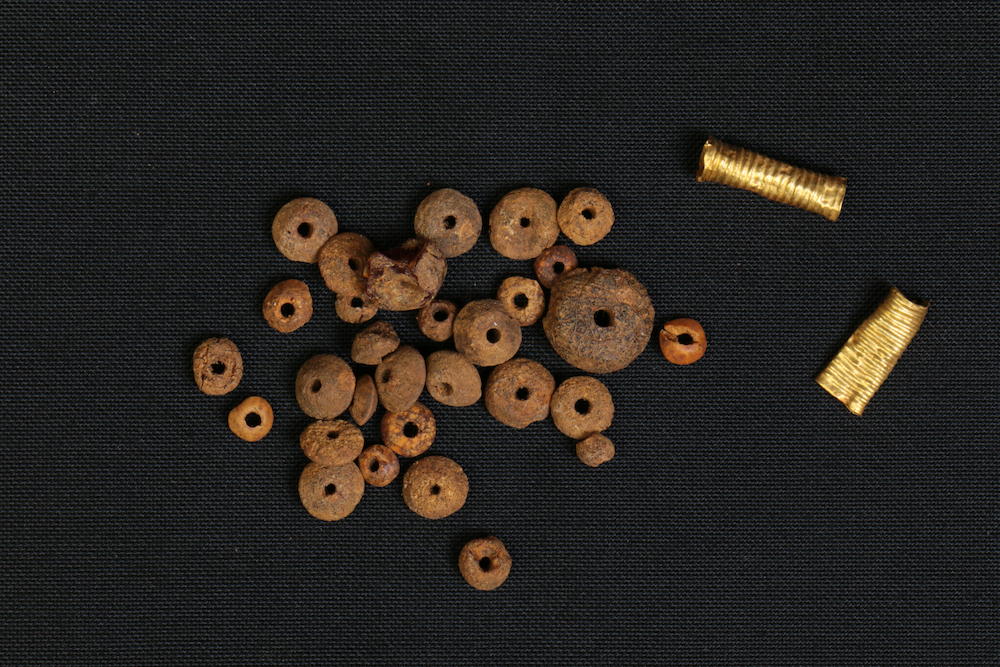
(19/ )
Bronze Age [- 2200/ - 800]
Amber bead necklace and gold ribbed tubular beads. These items were found in the burial of a Bronze Age woman. The aesthetic qualities and rarity of amber made it a sought-after product for the Bronze Age elite. This raw material was generally from Jütland and the Baltic Sea coast.
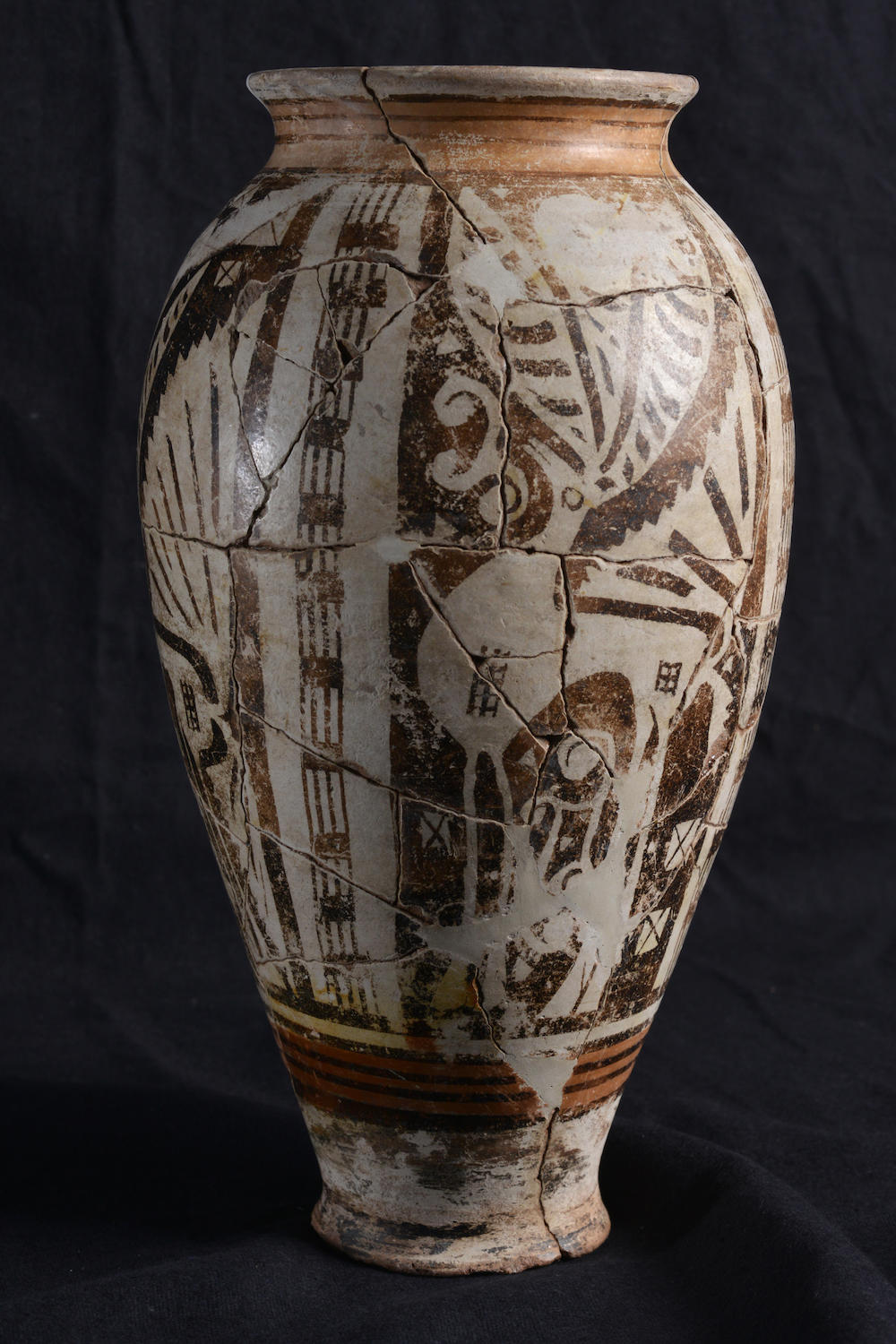
(20/ )
Iron Age [- 800/ - 50]
Gallic vase in fine painted ceramic (late Iron Age, 2nd century BCE). Its tapered body with a deer motif and its well-marked high shoulder surmount a slender foot. The Arvernian ceramists used the technique of the reserve, similar to that of Greek ceramics with red figures, but they used a black pigment of organic origin.
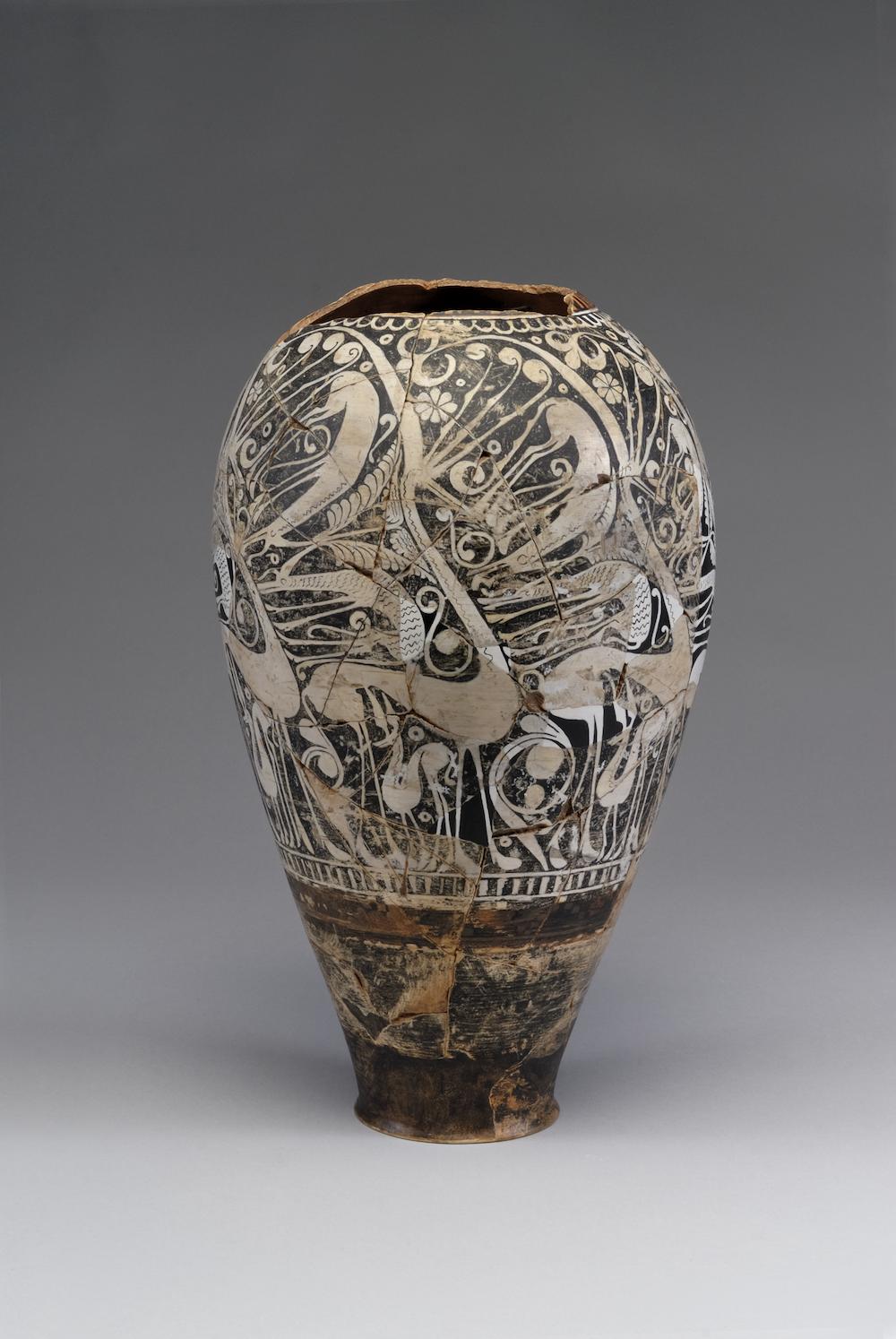
(21/ )
2nd Iron Age [- 480/ - 50]
Gallic vase in fine painted pottery (late Iron Age, 2nd century BCE). Its tapered body and well-marked high shoulder surmount a slender foot. Its inner wall is coated with pitch. The Arvernian ceramists used the technique of the reserve, similar to that of Greek ceramics with red figures, but they used a black pigment of organic origin.
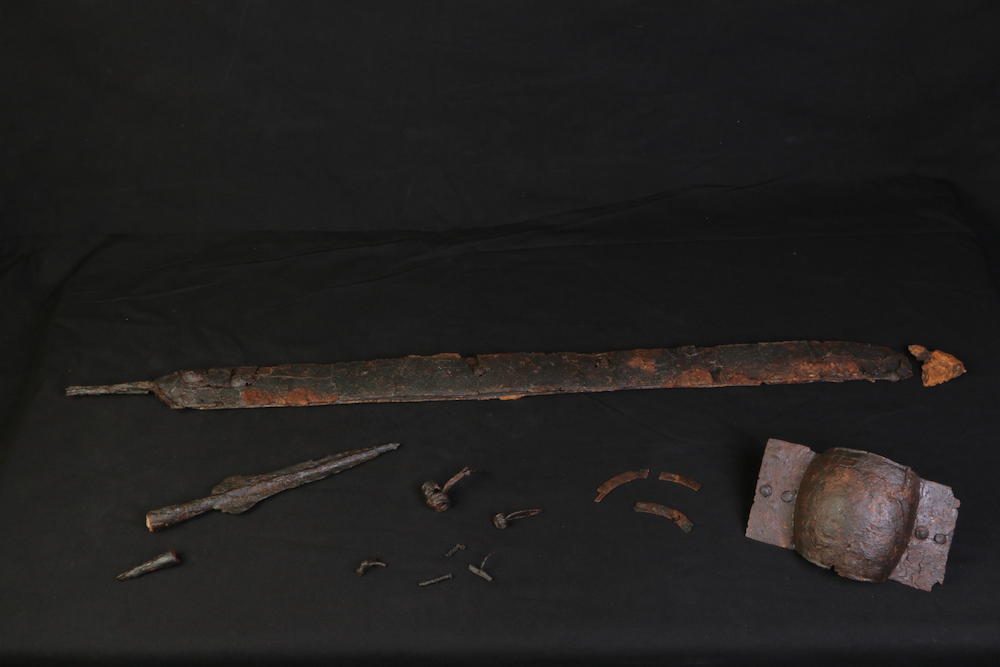
(22/ )
Iron Age [- 800/ - 50]
Set of Gallic iron relics: sword in its scabbard; iron and heel of a spear; three fibulae (brooches), two of which are linked by a chain; belt ring with a button; umbo of a finned shield. The umbo is a domed or conical piece of iron or bronze in the middle of a shield, to protect the hand.
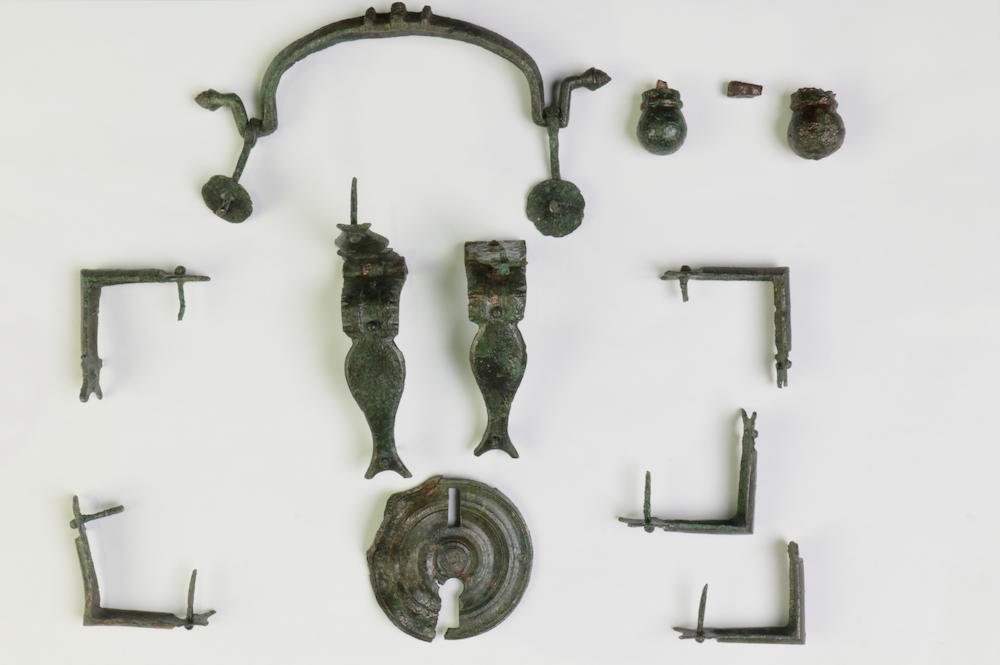
(23/ )
Early Imperial [27 / 235]
Metal elements of a High Kingdom case (1st century BCE - 3rd century CE): lock casing; handle; five corner elements and two hinge elements.
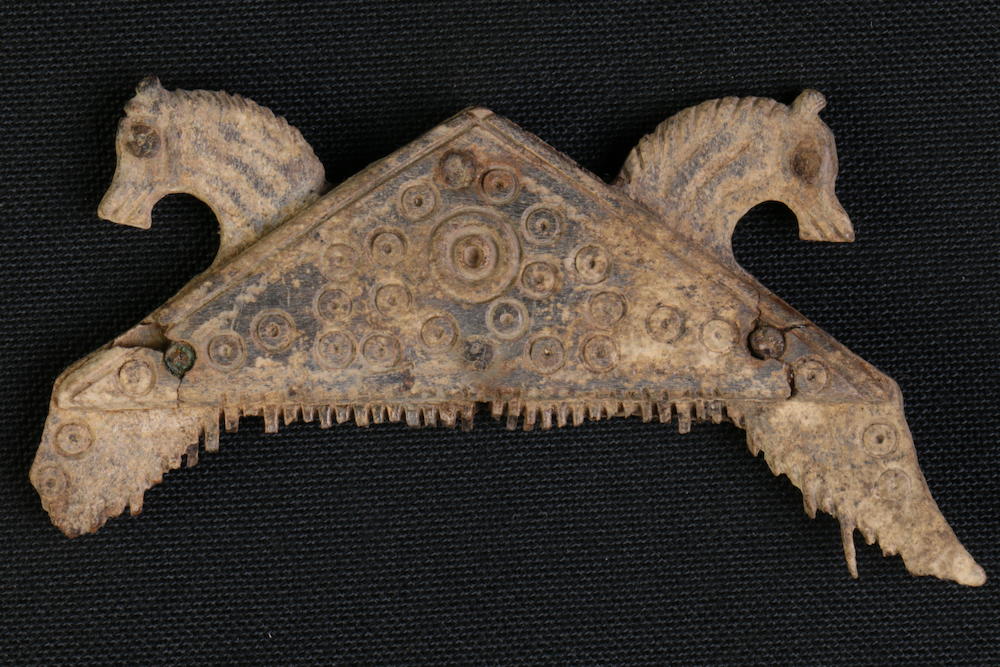
(24/ )
Bas-Empire [235/ 476]
Ornate comb head in the form of a bone pediment, dated to the 4th century. All the teeth of the comb are broken. Double-toothed combs were used for grooming. The large teeth were used for detangling while the small ones were used for delousing and combing.
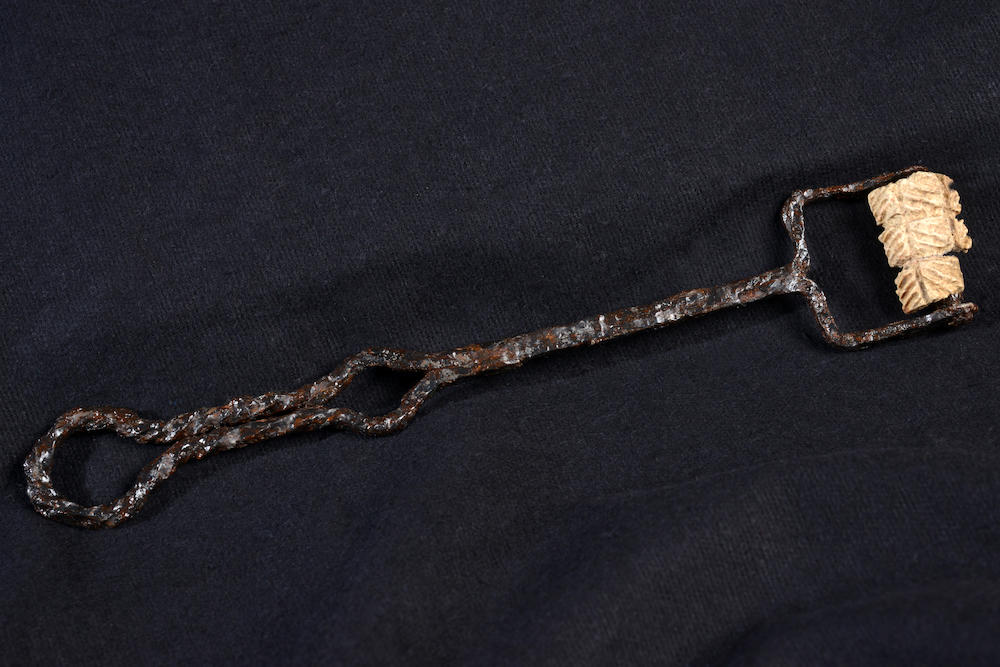
(25/ )
Iron Age [- 800/ - 50]
Potter's wheel with an iron handle and a bone wheel. The handle is made of two twisted wires that separate twice to form a circle. This wheel was used to apply a repetitive decoration, most often stylized, on the body of ceramics
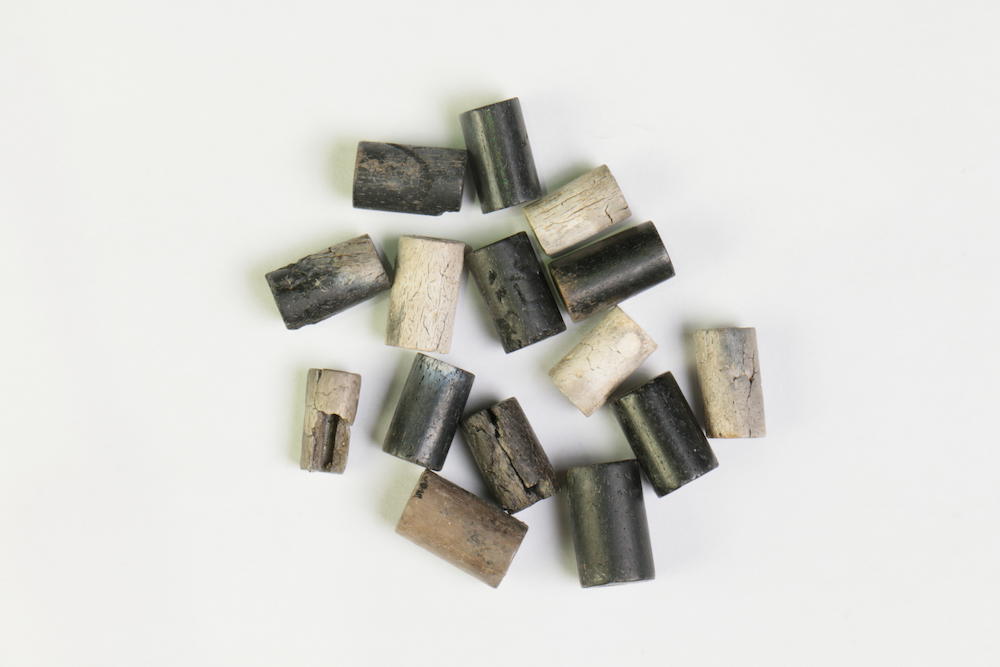
(26/ )
Bas-Empire [235/ 476]
Fifteen tubular ivory beads from the Early Period. They were found in a cremation tomb. During the Late Antiquity, the production of ivory experienced an unprecedented boom. The aristocracy is fond of this exotic luxury product that is brought from Africa or India.
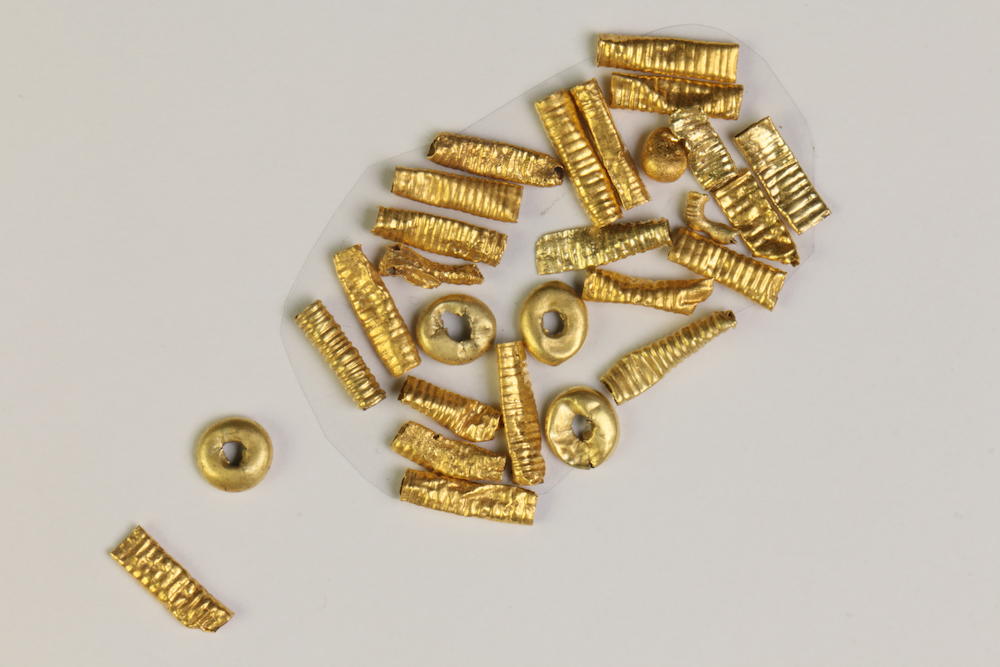
(27/ )
Early Imperial [27 / 235]
Tubular gold bead necklace from the Early Period. It was found in a rich cremation tomb that also contained ivory beads. This necklace testifies to the prosperity of the landed aristocracy of the Early Kingdom.

(28/ )
Early Imperial [27 / 235]
The Face of Love
Cameos are small objects made of stone or glass paste with carved or molded decoration in slight relief. Closely associated with the field of adornment, this production was developed by the Romans and spread to Gaul from the time of the High Empire. The iconography often draws from the Greek-Roman mythological repertoire. Here, the combination of a childish face with full cheeks and a pair of wings, no doubt allows one to recognize Éros, the personification of love desire.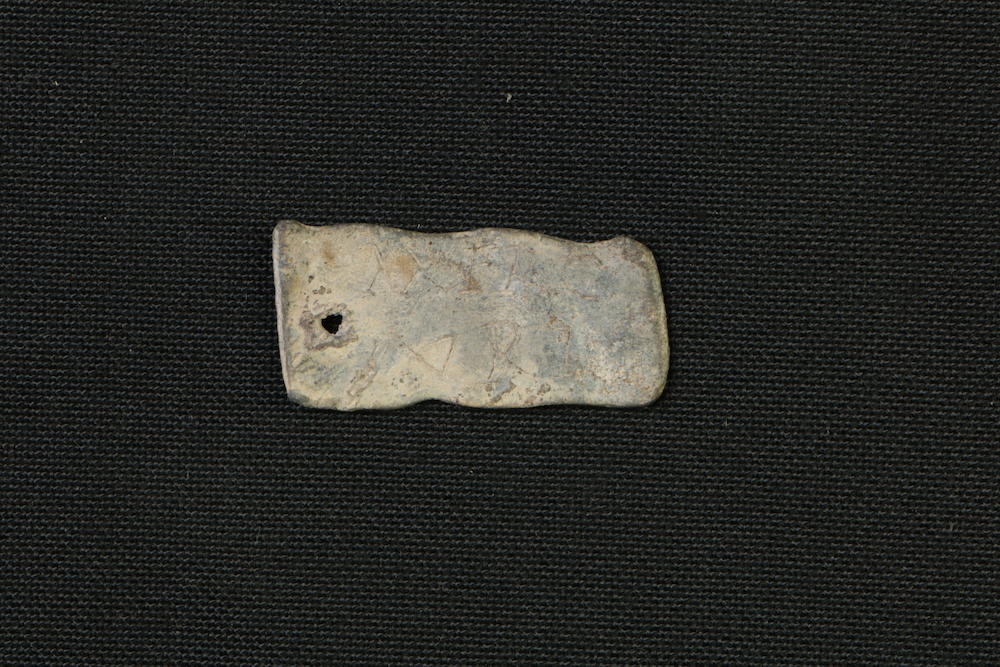
(29/ )
Early Imperial [27 / 235]
Rectangular lead label with an inscription on both sides. Its small perforation made it possible to label the goods. Dated to the Early Empire, it was discovered during the excavation of a public monumental district of Augustonemetum. Numerous small lead weights were discovered, testifying to commercial activity in this sector of the city.
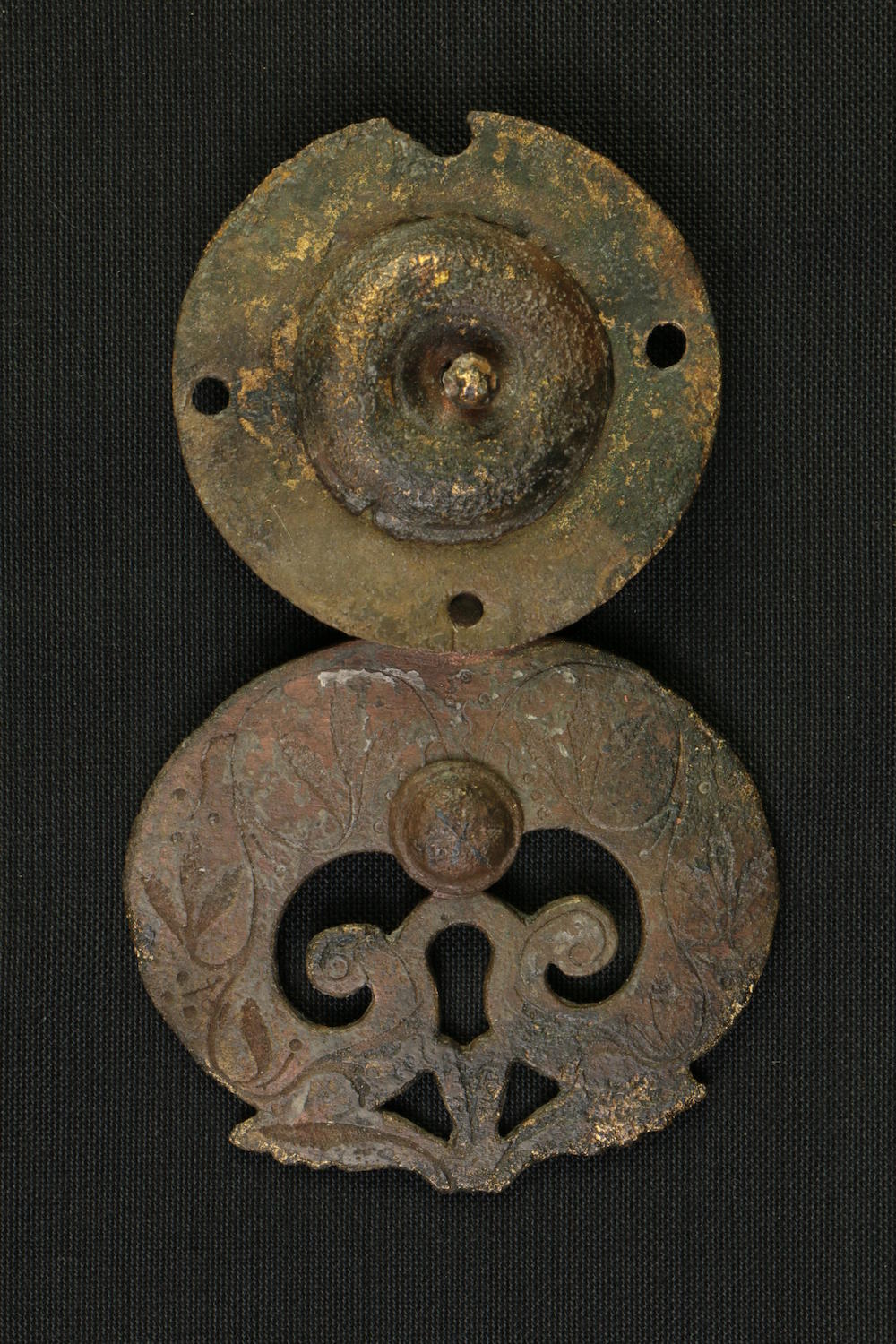
(30/ )
Early Imperial [27 / 235]
This phalere (small decorative element), finely decorated, adorned a horse's harness. It dates back to the High-Empire.
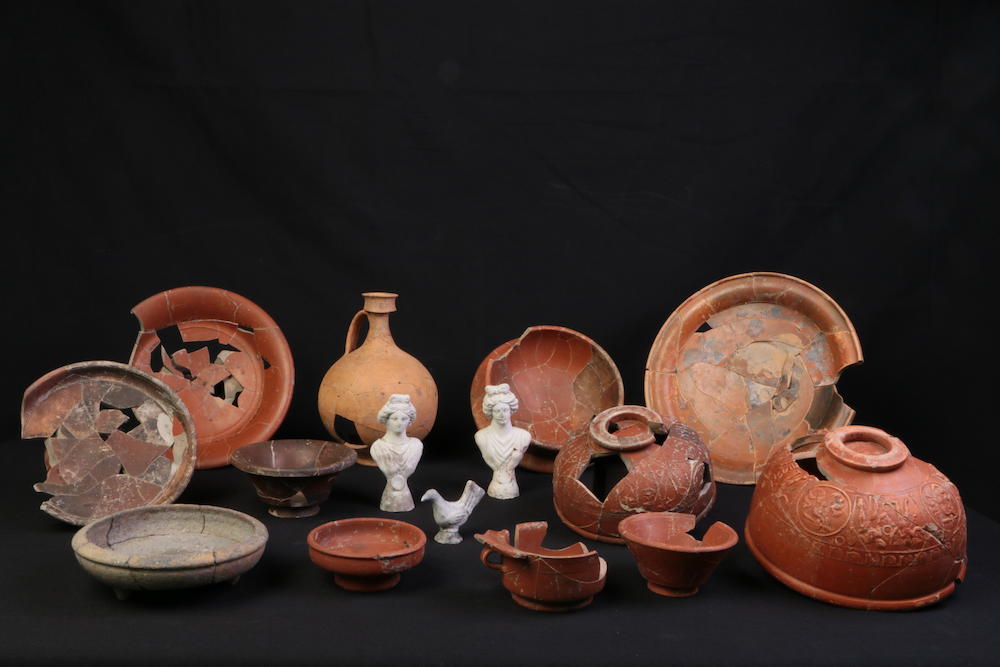
(31/ )
Early Imperial [27 / 235]
Dishes, plates, jugs, cups, bowls, skyphos (a kind of cup with two handles), most of them in sigillated ceramic with a stamp on the bottom or in clear common ceramic. The figurines are made of white terracotta from the Allier. These objects come from a funerary complex dating from the 2nd century AD. At that time, the population practiced cremation "à la romaine".
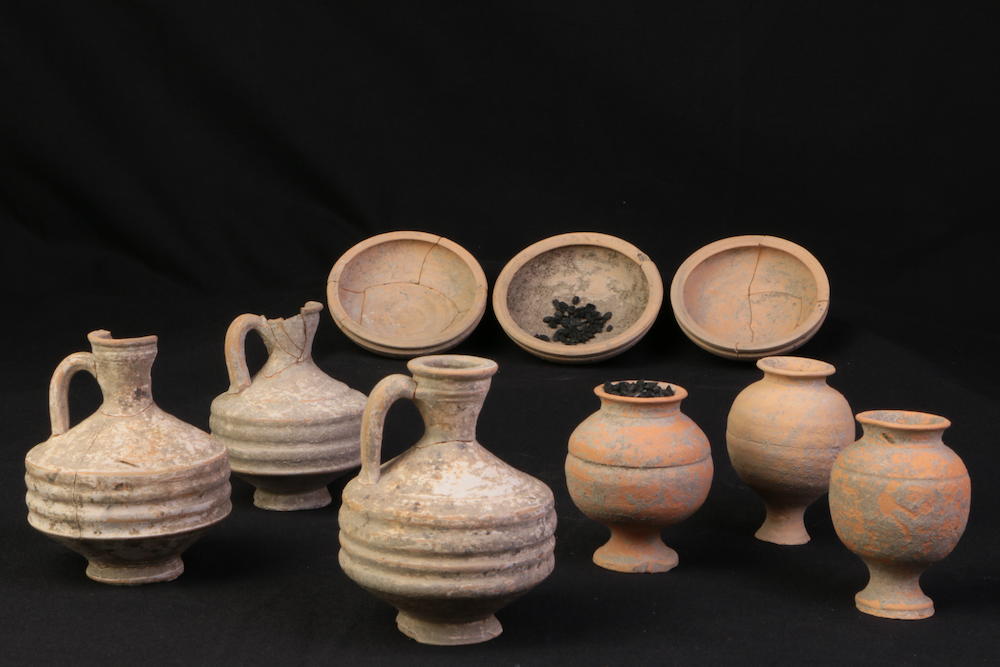
(32/ )
Early Imperial [27 / 235]
Three pots, three bowls and three miniature jugs made of clear ceramic, some covered with a white slip. Several of them originally contained plants (beans, dressed barley, rose hip kernel) which attest to the practice of a funeral meal. In fact, these objects come from a funerary complex dating from the second century AD. At that time, the population practiced cremation "à la romaine".
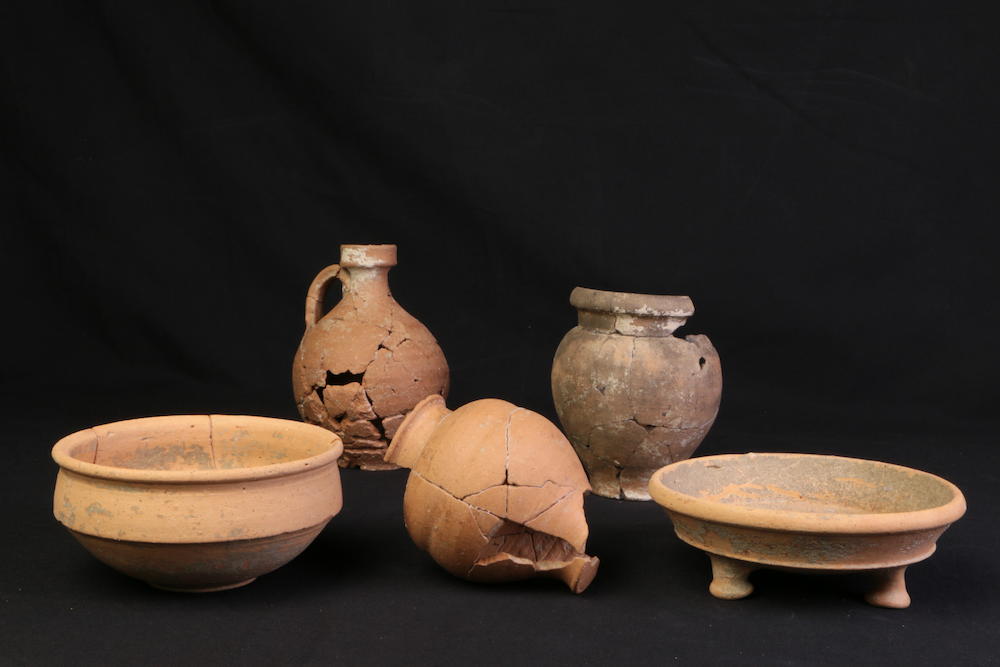
(33/ )
Bas-Empire [235/ 476]
Three pots, three bowls and three miniature jugs in clear ceramic, some covered with a white slip. Several of them originally contained plants (beans, dressed barley, rosehips) which attest to the practice of a funeral meal. In fact, these objects come from a funerary complex dating from the second century AD. At that time, the population practiced cremation "à la romaine".